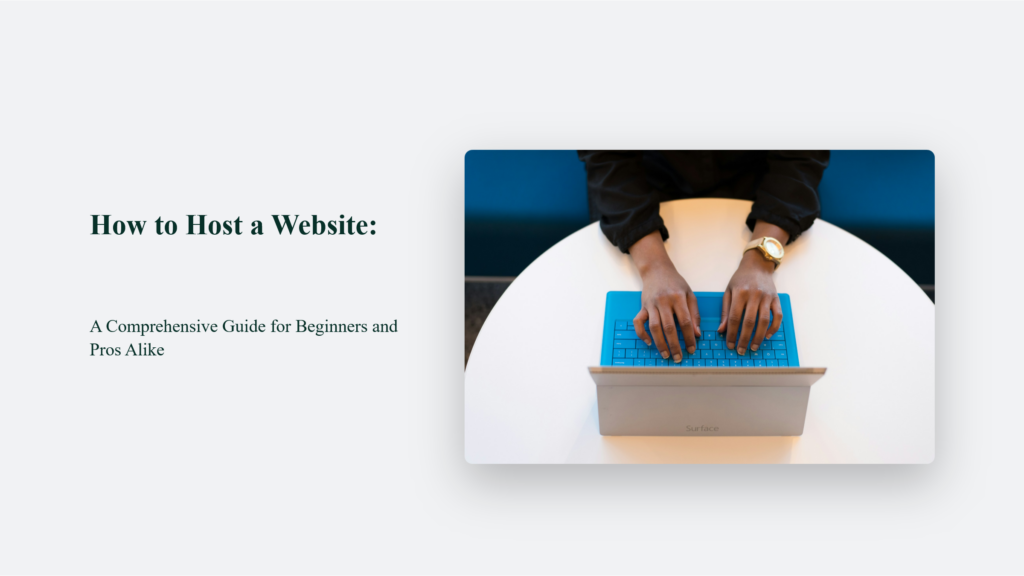

How to Host a Website: A Comprehensive Guide for Beginners and Pros Alike

As Seen On
Hosting a website might seem like a Herculean task, but in reality, it’s more like assembling a piece of IKEA furniture. It might look complex at first glance, but once you understand the components and follow a systematic approach, it’s quite manageable. So, let’s dive in and find out the intricacies of how to host a website.
Key Takeaways:
- Evaluate your website’s needs in terms of traffic, security, and budget.
- Choose a hosting type that aligns with your needs: shared, VPS, dedicated, or cloud.
- Look for hosting plans within your budget, starting from as low as $1.99/month.
- Select a domain name that is memorable, relevant, and straightforward.
- Use the control panel provided by your hosting service for easy website management.

But first, What is Hosting?
Web hosting is essentially the digital equivalent of renting real estate, but instead of land, you’re renting space on a server to house your website. Think of it as leasing a little corner of the internet where your website can comfortably live and be accessed by visitors worldwide. Just like in real estate, location (or, in this case, the quality of the hosting service) matters. A good hosting provider ensures your website is always accessible, loads quickly, and doesn’t end up in the bad neighbourhood of the internet, where sites go down more often than a see-saw at a playground.
How to Host a Website:
Understanding Your Hosting Needs
Understanding your hosting needs is akin to planning a vacation: you need to know your destination, budget, and the kind of experience you’re after before you can pack your bags. It translates to understanding your website’s bandwidth requirements, security needs, and budget constraints in web hosting.
Bandwidth: The Highway of Web Traffic
Bandwidth in web hosting is like the width of a highway; the wider it is, the more traffic (data) it can handle at once. If your website is a small blog, it’s like a serene country road – not much bandwidth is needed. But if you’re running an e-commerce site, expect the digital equivalent of rush-hour traffic. You’ll need a hosting plan with enough bandwidth to ensure your visitors don’t experience the online equivalent of a traffic jam.
Security: The Digital Locks and Alarms
Security is similar to protecting your home. Basic security measures might suffice for a personal blog – think deadbolt locks. But for a website handling sensitive data, like an online store, you need a security system that’s more Fort Knox – robust firewalls, SSL certificates, and regular backups. As Wix.com points out, ensuring the safety of customer data should be a top priority, especially if you’re accepting payments online.
Budget: Balancing Cost and Quality
Determining your budget is like deciding between a backpacking trip and a luxury cruise. Shared hosting is the budget-friendly hostel of the web world – cost-effective but with limited resources. VPS (Virtual Private Server) hosting is more like a mid-range hotel, offering better performance at a higher price. And if you’re looking at dedicated hosting, you’re in the realm of luxury resorts – top-notch performance and control, but with a price tag to match. As WPBeginner suggests, starting with a low-cost shared hosting plan is wise, especially if you’re just dipping your toes in the digital waters.

Choosing the Right Type of Hosting
Selecting the right type of hosting for your website can be compared to finding the perfect living space—it needs to fit your lifestyle (or, in this case, your website’s needs) while staying within your budget.
Shared Hosting: The Budget-Friendly Apartment
Shared hosting is the most budget-conscious option, ideal for small websites or blogs. Think of it as renting a room in a shared apartment. You have your own space (website) but share the building’s resources (server) with other tenants (websites). It means if one website gets a lot of traffic, it could affect your website’s performance. It’s an economical choice, but not without its compromises.
VPS Hosting: The Spacious Condo
VPS hosting is a step up, like moving into a condo. You have more room (resources) and more control over your environment. While you still share the building with others, you have fewer neighbours and a defined space just for you. This type of hosting is great for websites that have outgrown shared hosting but aren’t quite ready for their own house (dedicated server).
Dedicated Hosting: The Private House
Dedicated hosting is like having your own house. You have all the space (server resources) to yourself, and you’re in complete control. This option is best for large, high-traffic websites that need a lot of resources. It’s the most expensive type of hosting, but it offers the highest performance and security. It’s perfect for businesses or advanced users needing that extra control and space.
Cloud Hosting: The Modern, Scalable Loft
Cloud hosting is the new kid on the block, offering a more flexible and scalable solution. Imagine living in a modern, high-tech loft that can magically expand and shrink based on your needs. This type of hosting uses multiple servers to balance the load and maximize uptime. It’s perfect for websites that experience fluctuating traffic, ensuring that your website can handle sudden spikes in visitors without a hitch.

Picking a Hosting Plan
When picking a hosting plan, think of it as a buffet. You’ve got your budget-friendly shared hosting, the all-you-can-eat option that’s light on the wallet. According to sources like WPBeginner, shared hosting plans are like the salad bar – basic but get the job done, with prices starting as low as $1.99 per month with providers like Bluehost.
Moving up the hosting food chain, we encounter VPS (Virtual Private Server) hosting. It’s akin to the main course – more satisfying and substantial. It offers a middle ground, both in terms of control and cost, more suited for websites that have outgrown the shared hosting plan but aren’t quite ready for the grandeur of a dedicated server.
Then there’s the crème de la crème, the dedicated hosting.
It’s like having an entire dessert cart to yourself. Dedicated hosting offers the highest level of resources and control but at a premium.
It’s ideal for high-traffic, resource-intensive websites needing high-performance server trimmings. As per Website Builder Expert, this option, while pricier, gives you the full control and resources of an entire server, akin to renting an entire banquet hall for a grand event.
So, when choosing your hosting plan, balancing your budget with your website’s needs is important. It’s like choosing between a quick snack and a full-course meal. You don’t want to overpay for resources you don’t need, but you also don’t want your site starving for more space and speed.
Remember, as your website grows, you can start at the salad bar and work up to the dessert cart. After all, you wouldn’t order the entire menu on your first visit to a restaurant.
The Domain Dilemma:
Selecting a domain name is akin to picking out a name for a new pet – it’s a fun yet serious business. This name will embody your digital identity, much like how ‘Mr. Whiskers’ or ‘Bark Twain’ might encapsulate your furry friend’s personality.
Why .com?
The .com domain is the golden retriever of domain extensions – universally recognized, loved, and trusted. While there are trendy new breeds (extensions) in the neighbourhood, .com remains the familiar face everyone knows and is comfortable with. It’s the extension that people default to typing – a critical factor in ensuring your website is easily accessible.
Simplicity is Key
When it comes to domain names, simplicity reigns supreme. Imagine calling your pet and having to shout a complicated, multi-syllable name across the park – not practical, right? The same goes for your domain. Keep it straightforward, easy to spell, and memorable. This way, your website won’t end up like that one guy at a party whose name everyone forgets.
Infuse Keywords Wisely
Just like you wouldn’t name your cat ‘Dog’ because it’s quirky, don’t force unrelated keywords into your domain name. However, if you can naturally include keywords that resonate with your brand or industry, you’re on the right track. It’s about striking a balance between creativity and relevance – a little like naming your cat ‘Paws’ instead of ‘Chair.’
Setting Up Your Website:
Setting up your website after acquiring your hosting and domain is like putting on a bow tie – it might seem tricky at first, but once you get the hang of it, you’ll look effortlessly sharp. Most hosting providers offer control panels that are so user-friendly that they make WordPress feel like it’s playing “hard to get” when, in reality, it’s just a few clicks away from being yours.
Imagine your website as a blank canvas and your control panel as a palette full of colours. With tools like WordPress, Joomla, or Drupal, you can easily paint your digital masterpiece. These Content Management Systems (CMS) are like the friendly neighbourhood Spider-Man of the web world – always there to save the day with their flexibility and user-friendliness.
And let’s not forget the customizations. Oh, the customizations! It’s like walking into a candy store where every sweet treat is free. Want to add a blog section? There’s a plugin for that. Dreaming of an online store? WooCommerce has got your back. Feel like integrating social media? It’s just a click away.
Setting up your website on these platforms is so straightforward it’s almost like telling your dog to sit. And just like your furry friend, once you give the command (or, in this case, a few clicks), you’re all set with a loyal, responsive, professional-looking site wagging its tail, ready to greet the digital world.
Remember:
Hosting a website isn’t rocket science but requires some planning and decision-making. Think of it as a journey – picking the right vehicle (hosting type), fueling it with the right plan, and then steering it towards your desired destination (your successful website).
Remember, your website is your digital handshake – make it count!
Frequently Asked Questions:
Can I host my website for free?
Yes, but with limitations. Free hosting often has restricted features and may not be ideal for a professional website.
How much does website hosting cost?
It can range from $1.99/month for basic shared hosting to over $100/month for high-end dedicated hosting.
Should I host my website or use a hosting company?
For convenience and reliability, using a hosting company is generally recommended, especially for beginners.
Konger
Up until working with Casey, we had only had poor to mediocre experiences outsourcing work to agencies. Casey & the team at CJ&CO are the exception to the rule.
Communication was beyond great, his understanding of our vision was phenomenal, and instead of needing babysitting like the other agencies we worked with, he was not only completely dependable but also gave us sound suggestions on how to get better results, at the risk of us not needing him for the initial job we requested (absolute gem).
This has truly been the first time we worked with someone outside of our business that quickly grasped our vision, and that I could completely forget about and would still deliver above expectations.
I honestly can't wait to work in many more projects together!
Disclaimer
*The information this blog provides is for general informational purposes only and is not intended as financial or professional advice. The information may not reflect current developments and may be changed or updated without notice. Any opinions expressed on this blog are the author’s own and do not necessarily reflect the views of the author’s employer or any other organization. You should not act or rely on any information contained in this blog without first seeking the advice of a professional. No representation or warranty, express or implied, is made as to the accuracy or completeness of the information contained in this blog. The author and affiliated parties assume no liability for any errors or omissions.

